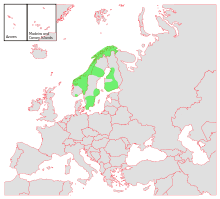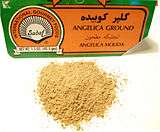Heracleum persicum
| Golpar | |
|---|---|
 | |
| Flower and leaf | |
| Scientific classification | |
| Kingdom: | Plantae |
| (unranked): | Angiosperms |
| (unranked): | Eudicots |
| (unranked): | Asterids |
| Order: | Apiales |
| Family: | Apiaceae |
| Genus: | Heracleum |
| Species: | H. persicum |
| Binomial name | |
| Heracleum persicum Desf. ex Fisch. | |

Heracleum persicum, commonly known as Persian hogweed or simply hogweed, is a flowering plant of the family Apiaceae, originally native to the region of Iran (Persia). It grows wild in humid mountainous regions in Iran, as well in some adjacent areas. Having been introduced in the 1830s, it has spread across Scandinavia. It is now very common in northern Norway, where it is known as the Tromsø palm.[1] The plant has also been spotted in Sweden.[2] In Finland, it has been declared as invasive species.[3]
Uses
Food uses
The seeds are used as a spice in Persian cooking. The very thin, small seed pods are aromatic and slightly bitter. They are usually sold in powdered form and are often erroneously sold as "angelica seeds". The powder is sprinkled over broad beans, lentils and other legumes, and potatoes. Golpar is also used in soups and stews. It is often used sprinkled over pomegranate arils.[4] Golpar is also mixed with vinegar into which lettuce leaves are dipped before eating.
Golpar can be used in small amounts (1 or 2 tsp per pound) when cooking beans to reduce the effect of gas in the digestive tract associated with consuming beans.[5]

In Persian cuisine, the petals are used in the spice mixture advieh to flavor rice dishes, as well as in chicken and bean dishes.
The tender leaves and leaf stalks can also be pickled (known as golpar toraei).
Poison
The juice from the plant is toxic and may cause skin reactions in exposed areas (phytotoxicity) when exposed to sunlight. This usually results in redness, itching, stinging, eczema and worst cases of severe burns (third degree burns) as the toxins make the skin sensitive to UV rays. This sensitivity may persist for up to one year after exposure.
Known ways to fight Tromsø palm are the constant cutting of new shoots. When cutting down, wear protective equipment, and remember to clean metal cutting tools after use as the juice is oxidising.
See also
- Heracleum, the genus
- Other Europe invasive species Heracleum mantegazzianum and Heracleum sosnowskyi
- Native Europe hog weeds Heracleum sphondylium and Heracleum sibiricum (Heracleum sphondylium subsp. sibiricum)
- Species that can be mistaken for tall invasive hogweeds wild parsnip, garden angelica, wild angelica
References
- ↑ Straumsheim Grønli, Kristin (July 10, 2006), Bjørnekjeks tar kvelertak på naturen (Hogweed takes stranglehold on nature), retrieved September 12, 2011
- ↑ "Heracleum mantegazzianum, Heracleum sosnowskyi and Heracleum persicum". EPPO Bulletin. 39 (3): 489–499. 2009. doi:10.1111/j.1365-2338.2009.02313.x.
- ↑ "Jättiputket (Heracleum persicum -ryhmä) - Vieraslajit.fi". vieraslajit.fi.
- ↑ Fujimori, Sachi (December 12, 2013). "Get cooking with pomegranates, the super fruit that's in season". NorthJersey.com. Retrieved December 31, 2013.
- ↑ "Gas in the Digestive Tract: Digestive Diseases - NIDDK".
External links
- Analysis of the Oil of Heracleum persicum L. (seeds and stems)
- Heracleum persicum, Heracleum glabrescens (in Persian)
- Sajjadi, S. E.; Noroozi, P. (2007). "Isolation and identification of xanthotoxin (8-methoxypsoralen) from the fruits of Heracleum persicum Desf. ex Fischer". Research in Pharmaceutical Sciences. April 2007 (2): 13–16. Retrieved 15 June 2016.